Legal Implications: Penalty Rates Reduction & Employment Law Essay
VerifiedAdded on 2023/05/30
|13
|3529
|182
Essay
AI Summary
This Year 10 Legal Studies argumentative essay examines the legal implications of the reduction of weekend and public holiday penalty rates for full-time and part-time workers in the hospitality, retail, and fast-food industries. It includes a hypothesis focusing on the negative impact of these changes on businesses and consumers. The essay outlines working questions related to employee satisfaction, productivity, and business profitability, and analyzes perspectives from various stakeholders, including employers, employees, consumers, and the government. A Y chart highlights the advantages and disadvantages of the current legislation, leading to a conclusion that the reforms may have an overall disadvantage for businesses and consumers in the long run. The assignment also includes a reference list of diverse sources.
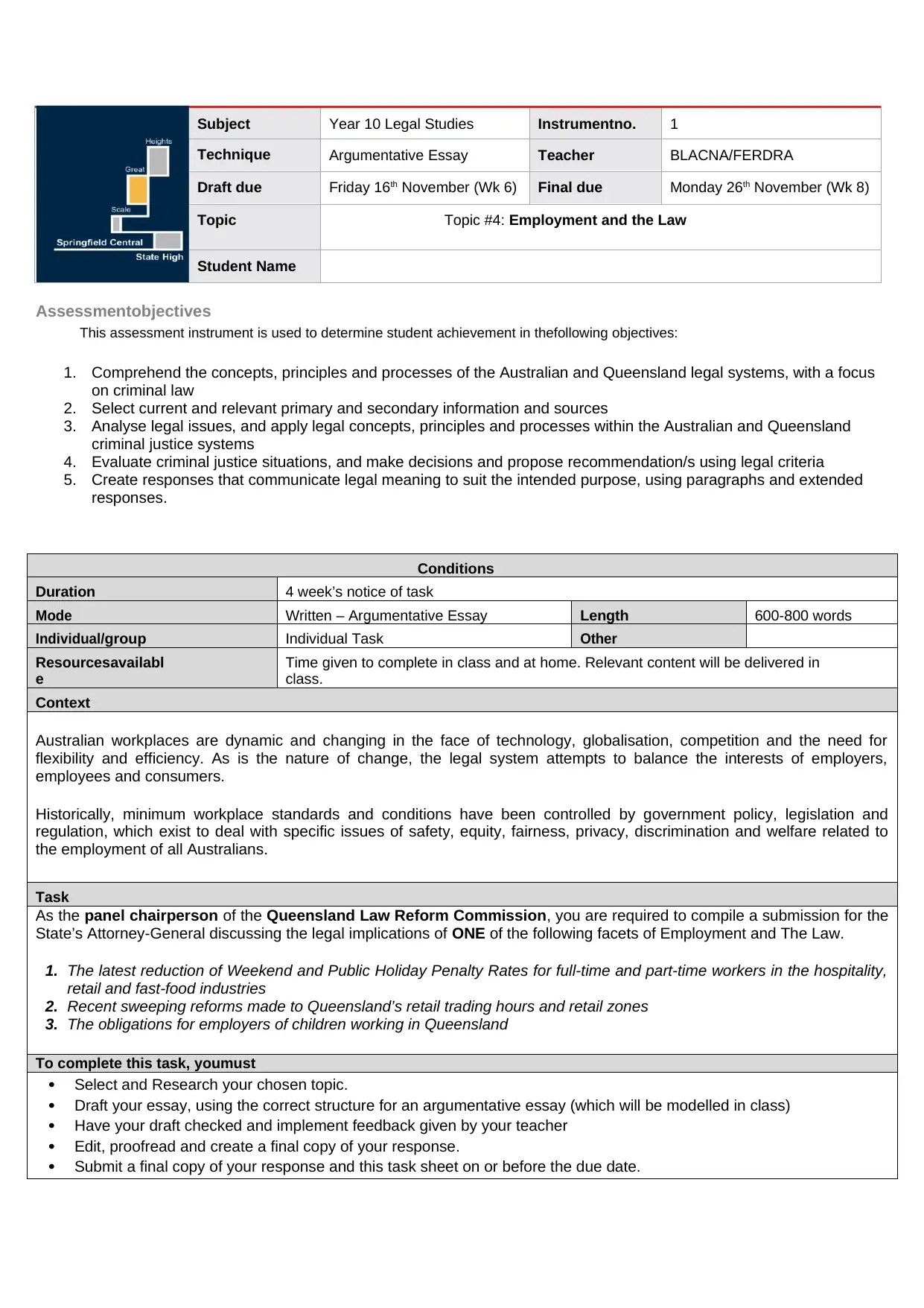
Subject Year 10 Legal Studies Instrumentno. 1
Technique Argumentative Essay Teacher BLACNA/FERDRA
Draft due Friday 16th November (Wk 6) Final due Monday 26th November (Wk 8)
Topic Topic #4: Employment and the Law
Student Name
Assessmentobjectives
This assessment instrument is used to determine student achievement in thefollowing objectives:
1. Comprehend the concepts, principles and processes of the Australian and Queensland legal systems, with a focus
on criminal law
2. Select current and relevant primary and secondary information and sources
3. Analyse legal issues, and apply legal concepts, principles and processes within the Australian and Queensland
criminal justice systems
4. Evaluate criminal justice situations, and make decisions and propose recommendation/s using legal criteria
5. Create responses that communicate legal meaning to suit the intended purpose, using paragraphs and extended
responses.
Conditions
Duration 4 week’s notice of task
Mode Written – Argumentative Essay Length 600-800 words
Individual/group Individual Task Other
Resourcesavailabl
e
Time given to complete in class and at home. Relevant content will be delivered in
class.
Context
Australian workplaces are dynamic and changing in the face of technology, globalisation, competition and the need for
flexibility and efficiency. As is the nature of change, the legal system attempts to balance the interests of employers,
employees and consumers.
Historically, minimum workplace standards and conditions have been controlled by government policy, legislation and
regulation, which exist to deal with specific issues of safety, equity, fairness, privacy, discrimination and welfare related to
the employment of all Australians.
Task
As the panel chairperson of the Queensland Law Reform Commission, you are required to compile a submission for the
State’s Attorney-General discussing the legal implications of ONE of the following facets of Employment and The Law.
1. The latest reduction of Weekend and Public Holiday Penalty Rates for full-time and part-time workers in the hospitality,
retail and fast-food industries
2. Recent sweeping reforms made to Queensland’s retail trading hours and retail zones
3. The obligations for employers of children working in Queensland
To complete this task, youmust
Select and Research your chosen topic.
Draft your essay, using the correct structure for an argumentative essay (which will be modelled in class)
Have your draft checked and implement feedback given by your teacher
Edit, proofread and create a final copy of your response.
Submit a final copy of your response and this task sheet on or before the due date.
Technique Argumentative Essay Teacher BLACNA/FERDRA
Draft due Friday 16th November (Wk 6) Final due Monday 26th November (Wk 8)
Topic Topic #4: Employment and the Law
Student Name
Assessmentobjectives
This assessment instrument is used to determine student achievement in thefollowing objectives:
1. Comprehend the concepts, principles and processes of the Australian and Queensland legal systems, with a focus
on criminal law
2. Select current and relevant primary and secondary information and sources
3. Analyse legal issues, and apply legal concepts, principles and processes within the Australian and Queensland
criminal justice systems
4. Evaluate criminal justice situations, and make decisions and propose recommendation/s using legal criteria
5. Create responses that communicate legal meaning to suit the intended purpose, using paragraphs and extended
responses.
Conditions
Duration 4 week’s notice of task
Mode Written – Argumentative Essay Length 600-800 words
Individual/group Individual Task Other
Resourcesavailabl
e
Time given to complete in class and at home. Relevant content will be delivered in
class.
Context
Australian workplaces are dynamic and changing in the face of technology, globalisation, competition and the need for
flexibility and efficiency. As is the nature of change, the legal system attempts to balance the interests of employers,
employees and consumers.
Historically, minimum workplace standards and conditions have been controlled by government policy, legislation and
regulation, which exist to deal with specific issues of safety, equity, fairness, privacy, discrimination and welfare related to
the employment of all Australians.
Task
As the panel chairperson of the Queensland Law Reform Commission, you are required to compile a submission for the
State’s Attorney-General discussing the legal implications of ONE of the following facets of Employment and The Law.
1. The latest reduction of Weekend and Public Holiday Penalty Rates for full-time and part-time workers in the hospitality,
retail and fast-food industries
2. Recent sweeping reforms made to Queensland’s retail trading hours and retail zones
3. The obligations for employers of children working in Queensland
To complete this task, youmust
Select and Research your chosen topic.
Draft your essay, using the correct structure for an argumentative essay (which will be modelled in class)
Have your draft checked and implement feedback given by your teacher
Edit, proofread and create a final copy of your response.
Submit a final copy of your response and this task sheet on or before the due date.
Paraphrase This Document
Need a fresh take? Get an instant paraphrase of this document with our AI Paraphraser

Checkpoints
Term 4, Week 4, Lesson 2: Task Given
Term 4, Week 6, Lesson 2: Submit Draft
Term 4, Week 7, Lesson 2: Submitfinal response.
Criterion Marksallocated Result
Comprehending Assessment objectives 1 5
Selecting Assessment objectives 2 4
Analysing Assessment objectives 3 6
Evaluating Assessment objectives4 6
Creating a response Assessment objectives 5 4
TOTAL 25
Authentication
strategies
Teacher will provide class time for taskcompletion.
Students must document the process, as indicated in thecheckpoints.
Teacher will collect and annotatedrafts.
Teacher will consult with each student as they develop theresponse.
Students must acknowledge allsources.
Feedback Teacher Comments:
________________________________________________________________________
________________________________________________________________________
________________________________________________________________________
________________________________________________________________________
________________________________________________________________________
________________________________________________________________________
________________________________________________________________________
________________________________________________________________________
Term 4, Week 4, Lesson 2: Task Given
Term 4, Week 6, Lesson 2: Submit Draft
Term 4, Week 7, Lesson 2: Submitfinal response.
Criterion Marksallocated Result
Comprehending Assessment objectives 1 5
Selecting Assessment objectives 2 4
Analysing Assessment objectives 3 6
Evaluating Assessment objectives4 6
Creating a response Assessment objectives 5 4
TOTAL 25
Authentication
strategies
Teacher will provide class time for taskcompletion.
Students must document the process, as indicated in thecheckpoints.
Teacher will collect and annotatedrafts.
Teacher will consult with each student as they develop theresponse.
Students must acknowledge allsources.
Feedback Teacher Comments:
________________________________________________________________________
________________________________________________________________________
________________________________________________________________________
________________________________________________________________________
________________________________________________________________________
________________________________________________________________________
________________________________________________________________________
________________________________________________________________________

Criterion The student work has the followingcharacteristics: Marks
Comprehending
Comprehensive understanding of a significant range of legal reform concepts, principles and processes of Employment and
the law.
Sophisticated use of legal terminology.
4-5
Sufficient understanding of a wide range of legal reform concepts, principles and/or processes of Employment and the law.
Effective use of legal terminology. 2-3
Identification of some legal reform concepts, principles or processes. 1
Does not satisfy any of the descriptorsabove. 0
Selecting
Discerning choice and use of a wide variety of authoritative current and relevant primary and secondary information and sources
relevant to Employment and the law.
Accurate reference list with full bibliographic details
References consistently and accurately cited in the text.
3-4
Adequate choice and use of a range of current and/or relevant primary and secondary information and/or sources relevant to
Employment and the law.
Basic reference list
Some references cited in the text.
2
Narrow use of primary and/or secondary information or sources and/or partial reference list with some bibliographic details. 1
Does not satisfy any of the descriptorsabove. 0
Analysing
Sophisticated application of significant legal concepts, principles and processes relevant to Employment and the law
Perceptive dissection and interpretation of information to determine the nature and define the scope of the legal issue
Perceptive examination of opposing viewpoints and consequences, with discerning use of evidence to support the analysis. 5-6
Considered application of relevant legal concepts, principles and processes relevant to Employment and the law
Effective dissection and interpretation of information to determine the nature and define the scope of the legal issue
Effective examination of relevant viewpoints and consequences, with sufficient use of evidence within the analysis. 3-4
Rudimentary description of legal concepts, principles and/or processes
Partial description of the nature and/or scope of the legal issue
Partial description or identification of viewpoints and consequences, with narrow use of evidence within the response. 1-2
Does not satisfy any of the descriptorsabove. 0
Evaluating
Insightful alternatives presented from the analysis and recommendation/s proposed
Discerning discussion of significant implications in terms of just and equitable outcomes
Critical synthesis of information with complex legal reasoning and justification. 5-6
Reasonable alternatives presented from the analysis and recommendation/s proposed
Effective discussion of relevant implications in terms of just and equitable outcomes
Purposeful synthesis of information with some legal reasoning. 3-4
Superficial alternatives presented and/or recommendation/s proposed
Partial description of implications
Narrow or inconsistent legal reasons. 1-2
Does not satisfy any of the descriptorsabove. 0
Creating a response
Accomplished control of the logical order, sequencing and development of ideas suited to the intended purpose
Concise expression and an astute choice of vocabulary
Accomplished use of communication conventions (with few errors) and correct formatting
3-4
Adequate control of the order, sequencing and development of ideas for the intended purpose
Appropriate use of vocabulary
Sufficient use of communication conventions and correct formatting
2
Partial control of the order, sequence or development of ideas
Some elements of formatting or inconsistent use of communication conventions. 1
Does not satisfy any of the descriptorsabove. 0
Comprehending
Comprehensive understanding of a significant range of legal reform concepts, principles and processes of Employment and
the law.
Sophisticated use of legal terminology.
4-5
Sufficient understanding of a wide range of legal reform concepts, principles and/or processes of Employment and the law.
Effective use of legal terminology. 2-3
Identification of some legal reform concepts, principles or processes. 1
Does not satisfy any of the descriptorsabove. 0
Selecting
Discerning choice and use of a wide variety of authoritative current and relevant primary and secondary information and sources
relevant to Employment and the law.
Accurate reference list with full bibliographic details
References consistently and accurately cited in the text.
3-4
Adequate choice and use of a range of current and/or relevant primary and secondary information and/or sources relevant to
Employment and the law.
Basic reference list
Some references cited in the text.
2
Narrow use of primary and/or secondary information or sources and/or partial reference list with some bibliographic details. 1
Does not satisfy any of the descriptorsabove. 0
Analysing
Sophisticated application of significant legal concepts, principles and processes relevant to Employment and the law
Perceptive dissection and interpretation of information to determine the nature and define the scope of the legal issue
Perceptive examination of opposing viewpoints and consequences, with discerning use of evidence to support the analysis. 5-6
Considered application of relevant legal concepts, principles and processes relevant to Employment and the law
Effective dissection and interpretation of information to determine the nature and define the scope of the legal issue
Effective examination of relevant viewpoints and consequences, with sufficient use of evidence within the analysis. 3-4
Rudimentary description of legal concepts, principles and/or processes
Partial description of the nature and/or scope of the legal issue
Partial description or identification of viewpoints and consequences, with narrow use of evidence within the response. 1-2
Does not satisfy any of the descriptorsabove. 0
Evaluating
Insightful alternatives presented from the analysis and recommendation/s proposed
Discerning discussion of significant implications in terms of just and equitable outcomes
Critical synthesis of information with complex legal reasoning and justification. 5-6
Reasonable alternatives presented from the analysis and recommendation/s proposed
Effective discussion of relevant implications in terms of just and equitable outcomes
Purposeful synthesis of information with some legal reasoning. 3-4
Superficial alternatives presented and/or recommendation/s proposed
Partial description of implications
Narrow or inconsistent legal reasons. 1-2
Does not satisfy any of the descriptorsabove. 0
Creating a response
Accomplished control of the logical order, sequencing and development of ideas suited to the intended purpose
Concise expression and an astute choice of vocabulary
Accomplished use of communication conventions (with few errors) and correct formatting
3-4
Adequate control of the order, sequencing and development of ideas for the intended purpose
Appropriate use of vocabulary
Sufficient use of communication conventions and correct formatting
2
Partial control of the order, sequence or development of ideas
Some elements of formatting or inconsistent use of communication conventions. 1
Does not satisfy any of the descriptorsabove. 0
⊘ This is a preview!⊘
Do you want full access?
Subscribe today to unlock all pages.

Trusted by 1+ million students worldwide

HYPOTHESIS
From your background reading/researching you will need to develop a Hypothesis Statement.
A HYPOTHESIS STATEMENT is a statement made as a starting point for further investigation. It is made on the
basis of known facts.
It uses the process of INDUCTIVE REASONING. This means to make general conclusions from specific information
or observations.
EXAMPLE USING HOMOSEXUAL MARRIAGES:
Currently under both federal and state legislation people of the same sex are not allowed to be married, however, in many overseas nations this practice is
accepted. This inequity should be addressed to allow homosexual marriages in Australia.
IDENTIFYyour statement and have your teacher approve it.
This statement will probably be subject to change as your research on the topic progresses. Therefore, you may need to
re-assess your statement and re-write it. A space has been provided if you find this necessary.
1. The recent reduction in relation to Weekend and Public Holiday Penalty Rates for part time and full time employees
in the retail, hospitality and fast-food industries have had a positive impact on business and consumers
2. The recent reduction in relation to Weekend and Public Holiday Penalty Rates for part time and full time
employees in the retail, hospitality and fast-food industries have had a negative impact on business and
consumers
Changed Statement
The recent reduction in relation to Weekend and Public Holiday Penalty Rates for part time and full time employees in
the retail, hospitality and fast-food industries have had a negative impact on business and consumers
From your background reading/researching you will need to develop a Hypothesis Statement.
A HYPOTHESIS STATEMENT is a statement made as a starting point for further investigation. It is made on the
basis of known facts.
It uses the process of INDUCTIVE REASONING. This means to make general conclusions from specific information
or observations.
EXAMPLE USING HOMOSEXUAL MARRIAGES:
Currently under both federal and state legislation people of the same sex are not allowed to be married, however, in many overseas nations this practice is
accepted. This inequity should be addressed to allow homosexual marriages in Australia.
IDENTIFYyour statement and have your teacher approve it.
This statement will probably be subject to change as your research on the topic progresses. Therefore, you may need to
re-assess your statement and re-write it. A space has been provided if you find this necessary.
1. The recent reduction in relation to Weekend and Public Holiday Penalty Rates for part time and full time employees
in the retail, hospitality and fast-food industries have had a positive impact on business and consumers
2. The recent reduction in relation to Weekend and Public Holiday Penalty Rates for part time and full time
employees in the retail, hospitality and fast-food industries have had a negative impact on business and
consumers
Changed Statement
The recent reduction in relation to Weekend and Public Holiday Penalty Rates for part time and full time employees in
the retail, hospitality and fast-food industries have had a negative impact on business and consumers
Paraphrase This Document
Need a fresh take? Get an instant paraphrase of this document with our AI Paraphraser

WORKING QUESTIONS
OUTLINE below the working questions that you will research (at least 5) that are related to the hypothesis. Check
that these questions suitably answer the marking criteria.
Whether the changes impact employee satisfaction
Whether the changes reduce productivity of the employee
Whether the changes lead to less profit for the businesses
Whether the impact of the change be positive or negative in the short term
Whether the impact of the changes be positive or negative in the long run
STAKEHOLDERS TO ISSUE
Employees
Employer (Businesses)
Consumers
Government
OUTLINE below the working questions that you will research (at least 5) that are related to the hypothesis. Check
that these questions suitably answer the marking criteria.
Whether the changes impact employee satisfaction
Whether the changes reduce productivity of the employee
Whether the changes lead to less profit for the businesses
Whether the impact of the change be positive or negative in the short term
Whether the impact of the changes be positive or negative in the long run
STAKEHOLDERS TO ISSUE
Employees
Employer (Businesses)
Consumers
Government
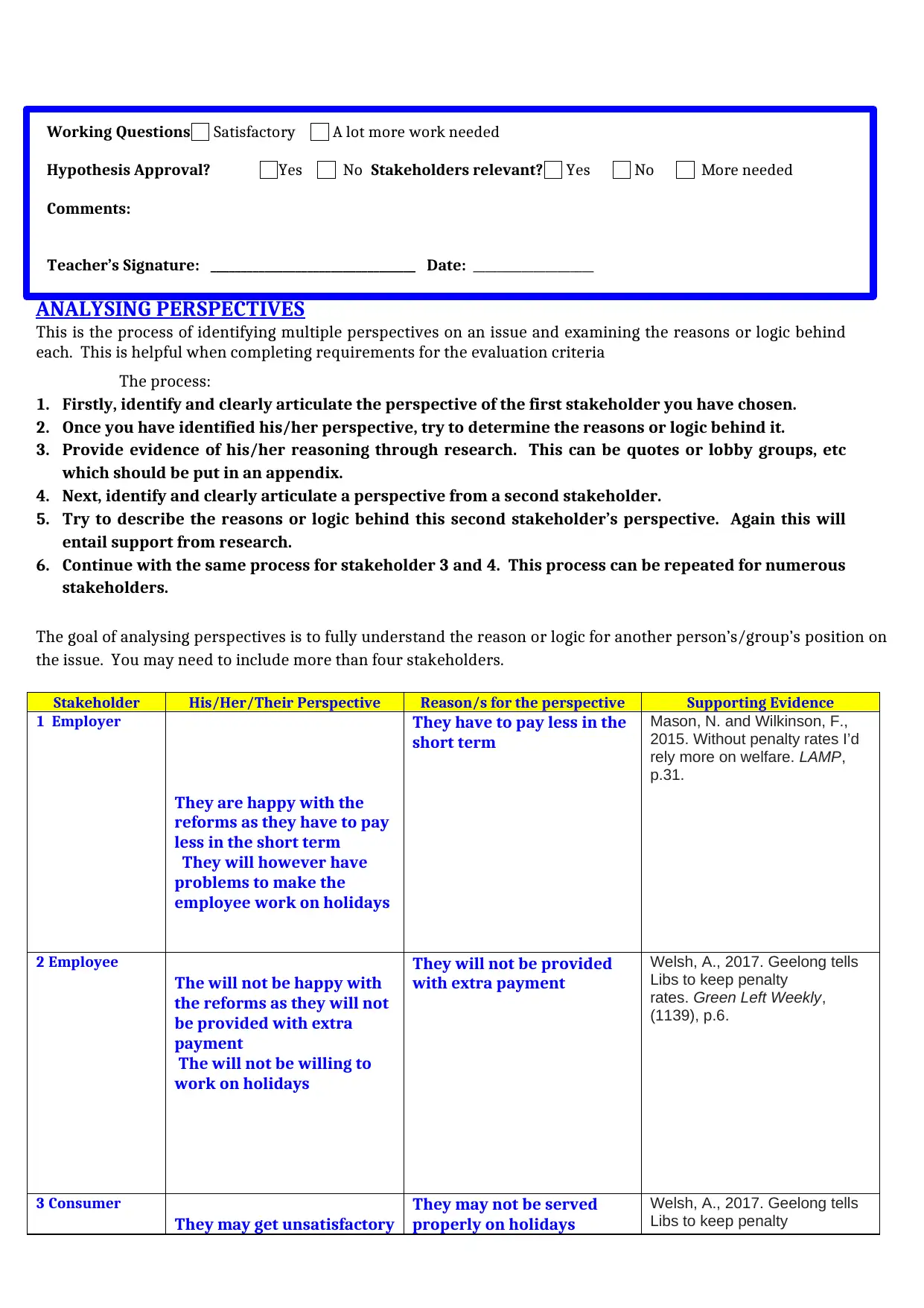
Working Questions Satisfactory A lot more work needed
Hypothesis Approval? Yes No Stakeholders relevant? Yes No More needed
Comments:
Teacher’s Signature: __________________________________ Date: ____________________
ANALYSING PERSPECTIVES
This is the process of identifying multiple perspectives on an issue and examining the reasons or logic behind
each. This is helpful when completing requirements for the evaluation criteria
The process:
1. Firstly, identify and clearly articulate the perspective of the first stakeholder you have chosen.
2. Once you have identified his/her perspective, try to determine the reasons or logic behind it.
3. Provide evidence of his/her reasoning through research. This can be quotes or lobby groups, etc
which should be put in an appendix.
4. Next, identify and clearly articulate a perspective from a second stakeholder.
5. Try to describe the reasons or logic behind this second stakeholder’s perspective. Again this will
entail support from research.
6. Continue with the same process for stakeholder 3 and 4. This process can be repeated for numerous
stakeholders.
The goal of analysing perspectives is to fully understand the reason or logic for another person’s/group’s position on
the issue. You may need to include more than four stakeholders.
Stakeholder His/Her/Their Perspective Reason/s for the perspective Supporting Evidence
1 Employer
They are happy with the
reforms as they have to pay
less in the short term
They will however have
problems to make the
employee work on holidays
They have to pay less in the
short term
Mason, N. and Wilkinson, F.,
2015. Without penalty rates I’d
rely more on welfare. LAMP,
p.31.
2 Employee
The will not be happy with
the reforms as they will not
be provided with extra
payment
The will not be willing to
work on holidays
They will not be provided
with extra payment
Welsh, A., 2017. Geelong tells
Libs to keep penalty
rates. Green Left Weekly,
(1139), p.6.
3 Consumer
They may get unsatisfactory
They may not be served
properly on holidays
Welsh, A., 2017. Geelong tells
Libs to keep penalty
Hypothesis Approval? Yes No Stakeholders relevant? Yes No More needed
Comments:
Teacher’s Signature: __________________________________ Date: ____________________
ANALYSING PERSPECTIVES
This is the process of identifying multiple perspectives on an issue and examining the reasons or logic behind
each. This is helpful when completing requirements for the evaluation criteria
The process:
1. Firstly, identify and clearly articulate the perspective of the first stakeholder you have chosen.
2. Once you have identified his/her perspective, try to determine the reasons or logic behind it.
3. Provide evidence of his/her reasoning through research. This can be quotes or lobby groups, etc
which should be put in an appendix.
4. Next, identify and clearly articulate a perspective from a second stakeholder.
5. Try to describe the reasons or logic behind this second stakeholder’s perspective. Again this will
entail support from research.
6. Continue with the same process for stakeholder 3 and 4. This process can be repeated for numerous
stakeholders.
The goal of analysing perspectives is to fully understand the reason or logic for another person’s/group’s position on
the issue. You may need to include more than four stakeholders.
Stakeholder His/Her/Their Perspective Reason/s for the perspective Supporting Evidence
1 Employer
They are happy with the
reforms as they have to pay
less in the short term
They will however have
problems to make the
employee work on holidays
They have to pay less in the
short term
Mason, N. and Wilkinson, F.,
2015. Without penalty rates I’d
rely more on welfare. LAMP,
p.31.
2 Employee
The will not be happy with
the reforms as they will not
be provided with extra
payment
The will not be willing to
work on holidays
They will not be provided
with extra payment
Welsh, A., 2017. Geelong tells
Libs to keep penalty
rates. Green Left Weekly,
(1139), p.6.
3 Consumer
They may get unsatisfactory
They may not be served
properly on holidays
Welsh, A., 2017. Geelong tells
Libs to keep penalty
⊘ This is a preview!⊘
Do you want full access?
Subscribe today to unlock all pages.

Trusted by 1+ million students worldwide

services from the business
and the employees
because of less people
working
rates. Green Left Weekly,
(1139), p.6.
4 Government
The government feels that it
would have a positive
impact on the economy
This is because it may
make the business more
productive.
(Productive Commission 2015)
and the employees
because of less people
working
rates. Green Left Weekly,
(1139), p.6.
4 Government
The government feels that it
would have a positive
impact on the economy
This is because it may
make the business more
productive.
(Productive Commission 2015)
Paraphrase This Document
Need a fresh take? Get an instant paraphrase of this document with our AI Paraphraser
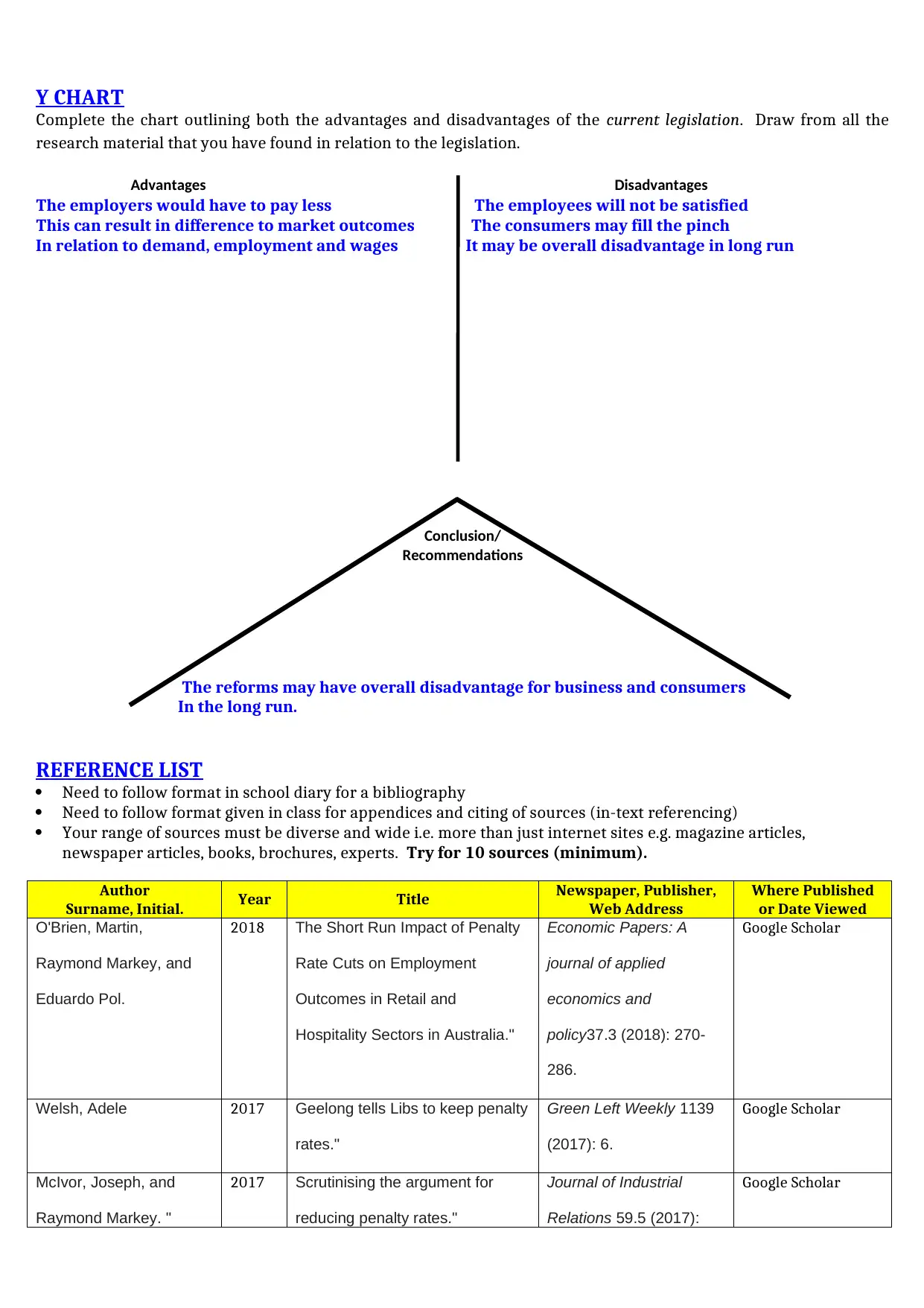
Y CHART
Complete the chart outlining both the advantages and disadvantages of the current legislation. Draw from all the
research material that you have found in relation to the legislation.
The employers would have to pay less The employees will not be satisfied
This can result in difference to market outcomes The consumers may fill the pinch
In relation to demand, employment and wages It may be overall disadvantage in long run
The reforms may have overall disadvantage for business and consumers
In the long run.
REFERENCE LIST
Need to follow format in school diary for a bibliography
Need to follow format given in class for appendices and citing of sources (in-text referencing)
Your range of sources must be diverse and wide i.e. more than just internet sites e.g. magazine articles,
newspaper articles, books, brochures, experts. Try for 10 sources (minimum).
Author
Surname, Initial. Year Title Newspaper, Publisher,
Web Address
Where Published
or Date Viewed
O'Brien, Martin,
Raymond Markey, and
Eduardo Pol.
2018 The Short Run Impact of Penalty
Rate Cuts on Employment
Outcomes in Retail and
Hospitality Sectors in Australia."
Economic Papers: A
journal of applied
economics and
policy37.3 (2018): 270-
286.
Google Scholar
Welsh, Adele 2017 Geelong tells Libs to keep penalty
rates."
Green Left Weekly 1139
(2017): 6.
Google Scholar
McIvor, Joseph, and
Raymond Markey. "
2017 Scrutinising the argument for
reducing penalty rates."
Journal of Industrial
Relations 59.5 (2017):
Google Scholar
Advantages Disadvantages
Conclusion/
Recommendations
Complete the chart outlining both the advantages and disadvantages of the current legislation. Draw from all the
research material that you have found in relation to the legislation.
The employers would have to pay less The employees will not be satisfied
This can result in difference to market outcomes The consumers may fill the pinch
In relation to demand, employment and wages It may be overall disadvantage in long run
The reforms may have overall disadvantage for business and consumers
In the long run.
REFERENCE LIST
Need to follow format in school diary for a bibliography
Need to follow format given in class for appendices and citing of sources (in-text referencing)
Your range of sources must be diverse and wide i.e. more than just internet sites e.g. magazine articles,
newspaper articles, books, brochures, experts. Try for 10 sources (minimum).
Author
Surname, Initial. Year Title Newspaper, Publisher,
Web Address
Where Published
or Date Viewed
O'Brien, Martin,
Raymond Markey, and
Eduardo Pol.
2018 The Short Run Impact of Penalty
Rate Cuts on Employment
Outcomes in Retail and
Hospitality Sectors in Australia."
Economic Papers: A
journal of applied
economics and
policy37.3 (2018): 270-
286.
Google Scholar
Welsh, Adele 2017 Geelong tells Libs to keep penalty
rates."
Green Left Weekly 1139
(2017): 6.
Google Scholar
McIvor, Joseph, and
Raymond Markey. "
2017 Scrutinising the argument for
reducing penalty rates."
Journal of Industrial
Relations 59.5 (2017):
Google Scholar
Advantages Disadvantages
Conclusion/
Recommendations
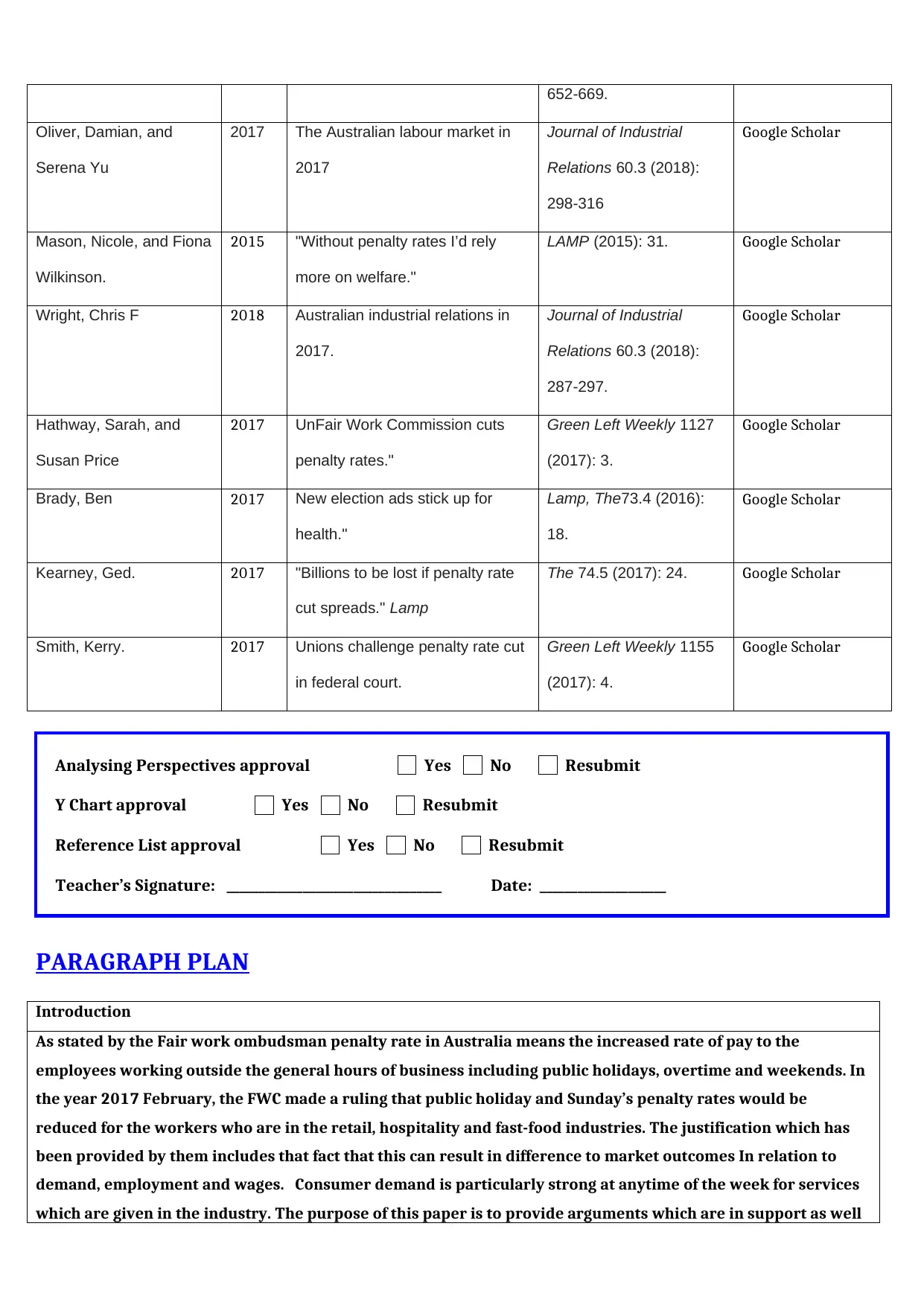
652-669.
Oliver, Damian, and
Serena Yu
2017 The Australian labour market in
2017
Journal of Industrial
Relations 60.3 (2018):
298-316
Google Scholar
Mason, Nicole, and Fiona
Wilkinson.
2015 "Without penalty rates I’d rely
more on welfare."
LAMP (2015): 31. Google Scholar
Wright, Chris F 2018 Australian industrial relations in
2017.
Journal of Industrial
Relations 60.3 (2018):
287-297.
Google Scholar
Hathway, Sarah, and
Susan Price
2017 UnFair Work Commission cuts
penalty rates."
Green Left Weekly 1127
(2017): 3.
Google Scholar
Brady, Ben 2017 New election ads stick up for
health."
Lamp, The73.4 (2016):
18.
Google Scholar
Kearney, Ged. 2017 "Billions to be lost if penalty rate
cut spreads." Lamp
The 74.5 (2017): 24. Google Scholar
Smith, Kerry. 2017 Unions challenge penalty rate cut
in federal court.
Green Left Weekly 1155
(2017): 4.
Google Scholar
Analysing Perspectives approval Yes No Resubmit
Y Chart approval Yes No Resubmit
Reference List approval Yes No Resubmit
Teacher’s Signature: __________________________________ Date: ____________________
PARAGRAPH PLAN
Introduction
As stated by the Fair work ombudsman penalty rate in Australia means the increased rate of pay to the
employees working outside the general hours of business including public holidays, overtime and weekends. In
the year 2017 February, the FWC made a ruling that public holiday and Sunday’s penalty rates would be
reduced for the workers who are in the retail, hospitality and fast-food industries. The justification which has
been provided by them includes that fact that this can result in difference to market outcomes In relation to
demand, employment and wages. Consumer demand is particularly strong at anytime of the week for services
which are given in the industry. The purpose of this paper is to provide arguments which are in support as well
Oliver, Damian, and
Serena Yu
2017 The Australian labour market in
2017
Journal of Industrial
Relations 60.3 (2018):
298-316
Google Scholar
Mason, Nicole, and Fiona
Wilkinson.
2015 "Without penalty rates I’d rely
more on welfare."
LAMP (2015): 31. Google Scholar
Wright, Chris F 2018 Australian industrial relations in
2017.
Journal of Industrial
Relations 60.3 (2018):
287-297.
Google Scholar
Hathway, Sarah, and
Susan Price
2017 UnFair Work Commission cuts
penalty rates."
Green Left Weekly 1127
(2017): 3.
Google Scholar
Brady, Ben 2017 New election ads stick up for
health."
Lamp, The73.4 (2016):
18.
Google Scholar
Kearney, Ged. 2017 "Billions to be lost if penalty rate
cut spreads." Lamp
The 74.5 (2017): 24. Google Scholar
Smith, Kerry. 2017 Unions challenge penalty rate cut
in federal court.
Green Left Weekly 1155
(2017): 4.
Google Scholar
Analysing Perspectives approval Yes No Resubmit
Y Chart approval Yes No Resubmit
Reference List approval Yes No Resubmit
Teacher’s Signature: __________________________________ Date: ____________________
PARAGRAPH PLAN
Introduction
As stated by the Fair work ombudsman penalty rate in Australia means the increased rate of pay to the
employees working outside the general hours of business including public holidays, overtime and weekends. In
the year 2017 February, the FWC made a ruling that public holiday and Sunday’s penalty rates would be
reduced for the workers who are in the retail, hospitality and fast-food industries. The justification which has
been provided by them includes that fact that this can result in difference to market outcomes In relation to
demand, employment and wages. Consumer demand is particularly strong at anytime of the week for services
which are given in the industry. The purpose of this paper is to provide arguments which are in support as well
⊘ This is a preview!⊘
Do you want full access?
Subscribe today to unlock all pages.

Trusted by 1+ million students worldwide

as arguments against the rule. The paper will also provide the negative implication of the rule on the Australian
economy.
Paragraph One
The changes in relation to the public penalty rates have taken effect on 1st July 2017. This rule has provoked
widespread controversy in relation to several affected and interested parties which include the federal
opposition to employer groups and unions. Consumers will get advantage from the pay cut as the shops will be
open all day. According to Adele (2017) penalty rates are the compensation which are provided to the
employees for working in out of service hours. However it has been argued by the FWC hat deterrence element
is the result of imposition of penalty rates instead of its objective.
Paragraph Two
It has been indicated by the public commission that shifts in relation social preferences and norms have take
away the distinctive role of Sundays where only few people will indulge in shopping or be involved in consumer
activities. Convenience value to the consumers and product diversity will be increased by Sunday penalty rates.
In addition lower capital with respect to under utilization would also be enhanced as services would be
available for longer time.
Paragraph Three
In the first place penalty rate cut does not in itself ensure that there would be more benefits to the consumers as
there would be longer hours of services and super employment or increased staffing as provided by the
productive commission. The gains in relation to extended opening hours can be limited to a specific
jurisdiction regulation in relation to trading hours. The findings of Lewis’ (2014) have also been dismissed by
McIvor and Markey (2017) with respect to employment effects of the penalty rates as his approach is based in
only hypothesis and theory. It does not have much support from any empirical data.
economy.
Paragraph One
The changes in relation to the public penalty rates have taken effect on 1st July 2017. This rule has provoked
widespread controversy in relation to several affected and interested parties which include the federal
opposition to employer groups and unions. Consumers will get advantage from the pay cut as the shops will be
open all day. According to Adele (2017) penalty rates are the compensation which are provided to the
employees for working in out of service hours. However it has been argued by the FWC hat deterrence element
is the result of imposition of penalty rates instead of its objective.
Paragraph Two
It has been indicated by the public commission that shifts in relation social preferences and norms have take
away the distinctive role of Sundays where only few people will indulge in shopping or be involved in consumer
activities. Convenience value to the consumers and product diversity will be increased by Sunday penalty rates.
In addition lower capital with respect to under utilization would also be enhanced as services would be
available for longer time.
Paragraph Three
In the first place penalty rate cut does not in itself ensure that there would be more benefits to the consumers as
there would be longer hours of services and super employment or increased staffing as provided by the
productive commission. The gains in relation to extended opening hours can be limited to a specific
jurisdiction regulation in relation to trading hours. The findings of Lewis’ (2014) have also been dismissed by
McIvor and Markey (2017) with respect to employment effects of the penalty rates as his approach is based in
only hypothesis and theory. It does not have much support from any empirical data.
Paraphrase This Document
Need a fresh take? Get an instant paraphrase of this document with our AI Paraphraser
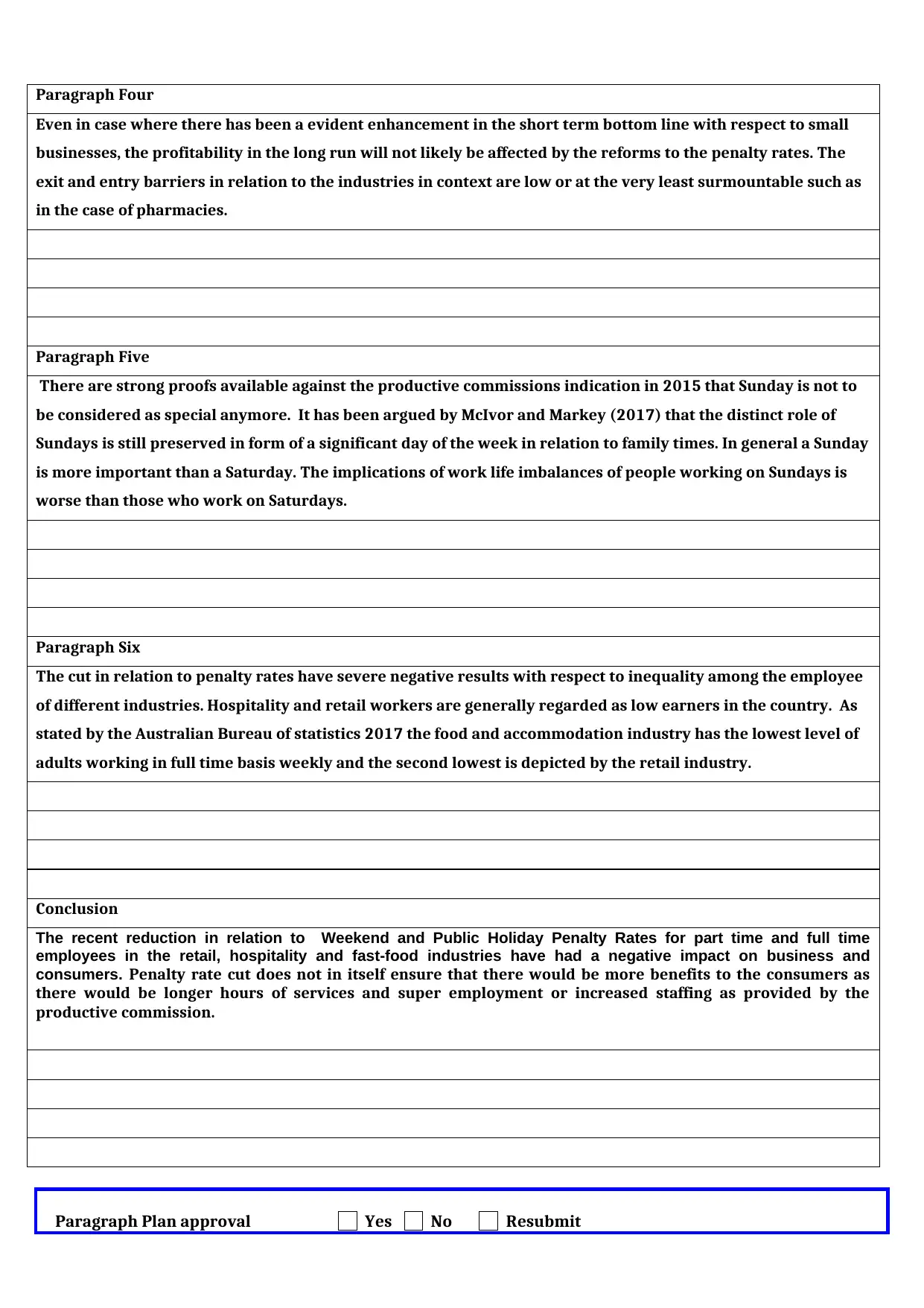
Paragraph Four
Even in case where there has been a evident enhancement in the short term bottom line with respect to small
businesses, the profitability in the long run will not likely be affected by the reforms to the penalty rates. The
exit and entry barriers in relation to the industries in context are low or at the very least surmountable such as
in the case of pharmacies.
Paragraph Five
There are strong proofs available against the productive commissions indication in 2015 that Sunday is not to
be considered as special anymore. It has been argued by McIvor and Markey (2017) that the distinct role of
Sundays is still preserved in form of a significant day of the week in relation to family times. In general a Sunday
is more important than a Saturday. The implications of work life imbalances of people working on Sundays is
worse than those who work on Saturdays.
Paragraph Six
The cut in relation to penalty rates have severe negative results with respect to inequality among the employee
of different industries. Hospitality and retail workers are generally regarded as low earners in the country. As
stated by the Australian Bureau of statistics 2017 the food and accommodation industry has the lowest level of
adults working in full time basis weekly and the second lowest is depicted by the retail industry.
Conclusion
The recent reduction in relation to Weekend and Public Holiday Penalty Rates for part time and full time
employees in the retail, hospitality and fast-food industries have had a negative impact on business and
consumers. Penalty rate cut does not in itself ensure that there would be more benefits to the consumers as
there would be longer hours of services and super employment or increased staffing as provided by the
productive commission.
Paragraph Plan approval Yes No Resubmit
Even in case where there has been a evident enhancement in the short term bottom line with respect to small
businesses, the profitability in the long run will not likely be affected by the reforms to the penalty rates. The
exit and entry barriers in relation to the industries in context are low or at the very least surmountable such as
in the case of pharmacies.
Paragraph Five
There are strong proofs available against the productive commissions indication in 2015 that Sunday is not to
be considered as special anymore. It has been argued by McIvor and Markey (2017) that the distinct role of
Sundays is still preserved in form of a significant day of the week in relation to family times. In general a Sunday
is more important than a Saturday. The implications of work life imbalances of people working on Sundays is
worse than those who work on Saturdays.
Paragraph Six
The cut in relation to penalty rates have severe negative results with respect to inequality among the employee
of different industries. Hospitality and retail workers are generally regarded as low earners in the country. As
stated by the Australian Bureau of statistics 2017 the food and accommodation industry has the lowest level of
adults working in full time basis weekly and the second lowest is depicted by the retail industry.
Conclusion
The recent reduction in relation to Weekend and Public Holiday Penalty Rates for part time and full time
employees in the retail, hospitality and fast-food industries have had a negative impact on business and
consumers. Penalty rate cut does not in itself ensure that there would be more benefits to the consumers as
there would be longer hours of services and super employment or increased staffing as provided by the
productive commission.
Paragraph Plan approval Yes No Resubmit

Teacher’s Signature: __________________________________ Date: ____________________
DRAFT DUE
Draft submitted on time Yes No
Teacher’s Signature: __________________________________ Date: ____________________
DRAFT DUE
Draft submitted on time Yes No
Teacher’s Signature: __________________________________ Date: ____________________
⊘ This is a preview!⊘
Do you want full access?
Subscribe today to unlock all pages.

Trusted by 1+ million students worldwide
1 out of 13
Your All-in-One AI-Powered Toolkit for Academic Success.
+13062052269
info@desklib.com
Available 24*7 on WhatsApp / Email
![[object Object]](/_next/static/media/star-bottom.7253800d.svg)
Unlock your academic potential
Copyright © 2020–2025 A2Z Services. All Rights Reserved. Developed and managed by ZUCOL.